Categories
Calendars
Guides
Reviews
Archive
Gallery
Articles
Ask Our Gardening Expert
How to Identify Different Oak Trees
These pages are here to assist you in identifying different species of oak trees. Identify the leaf, then click on the link for more detailed information and pictures.
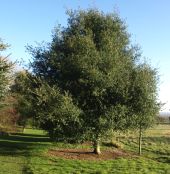
Coast Live Oak, click to enlarge
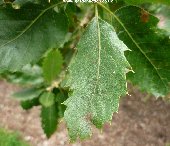
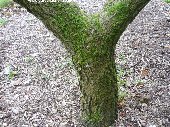 A rare oak tree, unlikely to be found other than in tree collections and arboretum.
A rare oak tree, unlikely to be found other than in tree collections and arboretum.Click here for more information and pictures.
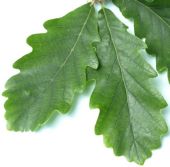
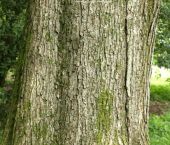 Sometimes also known as the Persian Oak.
Sometimes also known as the Persian Oak.Click here for more information and pictures.
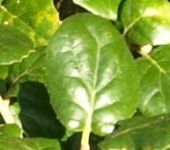 PICTURE OF COAST LIVE OAK ACORN
The leaves of the Coast Live Oak identify it well. The are shiny
green and evergreen.
PICTURE OF COAST LIVE OAK ACORN
The leaves of the Coast Live Oak identify it well. The are shiny
green and evergreen.The acorns are also unusual. They are long and thin with a red fruit.
Click here for more info.
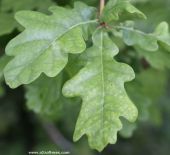
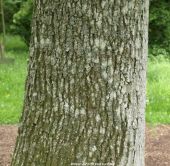 The most common oak tree in the UK is is also known as the
English Oak and the German Oak. The leaves are on stems less than 10mm long.
The most common oak tree in the UK is is also known as the
English Oak and the German Oak. The leaves are on stems less than 10mm long. Click here for more information and photos.
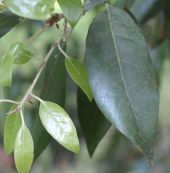
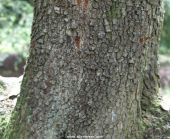 This oak is instantly recognisable by the
leathery, glossy leaves which are evergreen. Also known as
the Holly Oak or simply the Evergreen Oak.
This oak is instantly recognisable by the
leathery, glossy leaves which are evergreen. Also known as
the Holly Oak or simply the Evergreen Oak.
Click here for more information and photos.
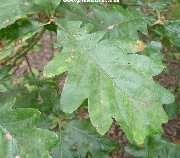
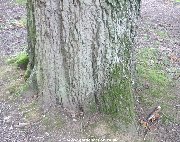 A stately and slow-growing tree, the Hungarian Oak is found in only
a few parks and arboretum in Europe and North America.
A stately and slow-growing tree, the Hungarian Oak is found in only
a few parks and arboretum in Europe and North America. Click here for more information and photos.
LEAF PICTURE HERE
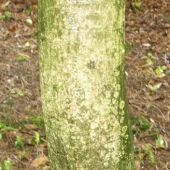 The Japanese Blue Oak (also known as the
Ring Cupped Oak). The "ring cup" comes from the delicate
ring markings on the mature acorns. A good medium sized tree
for many locations.
The Japanese Blue Oak (also known as the
Ring Cupped Oak). The "ring cup" comes from the delicate
ring markings on the mature acorns. A good medium sized tree
for many locations.Click here for more information and pictures.
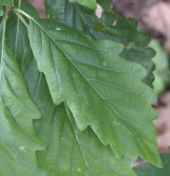
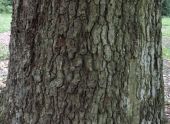
Mirbeck's Oak or the Algerian Oak after the country where it most commonly grows wild.
Click here for more information and pictures.
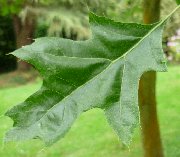
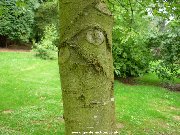
The Northern Pin Oak has deeply lobed leaves with angled ends. The leaves are a glossy green turning to a deep red in autumn / fall.
Click here for more information and pictures.
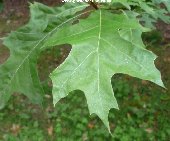
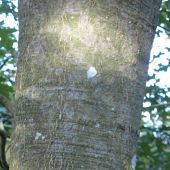
The Nuttall Oak is mainly found in North America. The oak like leaves are longer and more defined compared to the Common Oak. They turn a lovely red colour in autumn/fall.
Click here for more information and pictures.
Pyrenean Oak (quercus pyrenaica)
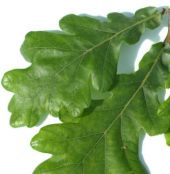
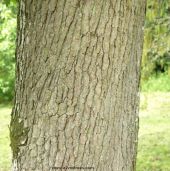 A very graceful oak tree with the variety
Quercus pyrenaica 'Pendula' being particularly attractive.
A very graceful oak tree with the variety
Quercus pyrenaica 'Pendula' being particularly attractive.Click here for more information and photos.
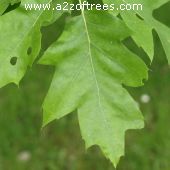
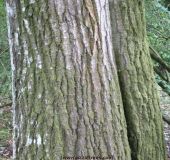 Native to the North East of the United
States, this oak tree is found all over the world in parks
and arboretums. The reason is the beautiful red colour of
the leaves in October time.
Native to the North East of the United
States, this oak tree is found all over the world in parks
and arboretums. The reason is the beautiful red colour of
the leaves in October time.Click here for more information and pictures.
Sessile Oak (quercus petraea)
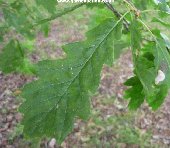
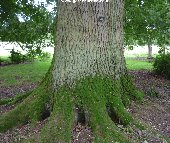 One of only two oak tree species native to the UK. Slender
trunk, sessile fruit and long-stemmed leaves identify this massive tree.
One of only two oak tree species native to the UK. Slender
trunk, sessile fruit and long-stemmed leaves identify this massive tree.Click here for more information and pictures.
Turkey Oak (quercus cerris)
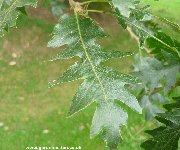
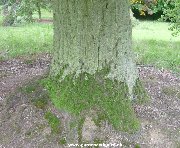 The Turkey Oak grows quicker than many other oak trees making it
good for ornamental purposes. The downside is the poor quality of the wood.
The Turkey Oak grows quicker than many other oak trees making it
good for ornamental purposes. The downside is the poor quality of the wood.Click here for more information and pictures.